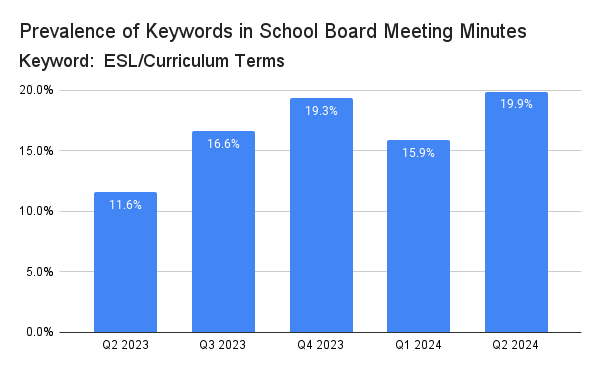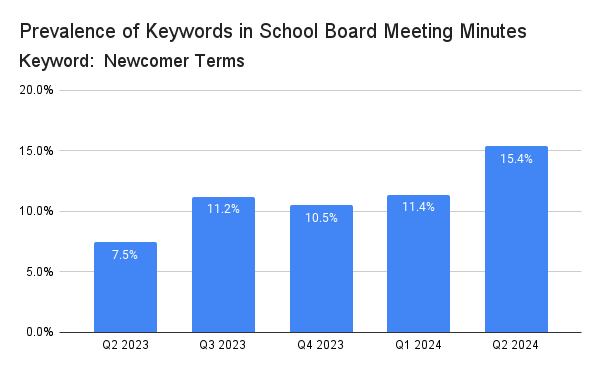1. Burbio's School Board Meeting Tracker covers school board meetings for over 2,000 school districts each month, representing over 60% of the K-12 school population. This week we look at the percent of districts that have discussed English Language Learner and Newcomer-related terms. A few notes:
- The percentages in each chart refer to districts that mentioned the measured terms at least once in the quarter.
- There is some "seasonality" related to this subject as onboarding and testing discussions occur most frequently in the Spring (Q2), Back to School (Q3), and late Fall periods (Q4), while being less frequent in Q1.
- We note the general increase in frequency of mentions of all terms, and in particular the year-over-year comparison between Q2 2023 and Q2 2024.
Our first chart covers a basket of terms related to ESL Curriculum. There was an increase from 11.3% in Q2 2023 to 19.9% in Q2 2024:
The next chart covers Newcomer-related terms (Newcomer, Immigrant, Migrant). Note the increase from 7.5% to 15.4% from Q2 2023 to Q2 2024.

The next chart is for references to English Language Learners, Bilingual Learners, Multi-language Learners, and ELL. Frequency of mentions more than doubled in the respective Q2 periods from 11.2% to 25.6%.
The final chart combines mentions of all the terms above. Just over 40% of districts mentioned one of the terms in Q4 2024, up from 21.4% the same quarter the previous year.

2. Burbio's State-Level Funding Tracker features continuously updated, state-specific grants for K-12 schools, covering all state departments, as well as Federal grants where states can tailor the criteria. Burbio has identified over 1,000 grants covering over $30 billion in spending. This week we extend our look at state priorities by examining Wisconsin, and highlight how their priorities appear in state grants.
Wisconsin’s 2023-25 state budget and the governor's budget message outline the following priorities:
- Mental health: "Let’s make sure every kid in Wisconsin has access to school-based mental health services through our “Get Kids Ahead” initiative. It’s the Year of Mental Health folks . . "
- CTE: "We’re also going to make sure our kids have the skills and tools they need to join the 21st Century workforce . . . "
- STEM: "I’m going to deliver on my pledge to improve access to computer science education in Wisconsin with a $10 million investment to bolster computer science education across our state . . "
- Teacher Development: "We should be able to pass common-sense proposals that already have broad, bipartisan support—especially those we know will help us retain and recruit a talented workforce . . "
The priorities are reflected in the following grants:
- Mental Health: School-Based Mental Health Services Funding moved from a competitive grant to a formula grant totaling $25 million per year.
- CTE: The Technical Education Equipment Grant awards between $5,000 and $50,000 to train high school students in advanced manufacturing fields.
- STEM: The "Fab Labs" Grant awards up to $25,000 per district to "(assist) districts with equipment purchases used for instructional and educational purposes in fabrication laboratories in Wisconsin schools."
- Teacher Development: The Peer Review and Mentoring Grant "funds the development of peer review and mentoring programs for beginning teachers in Wisconsin public schools."
3. In our previous School Tracker we reviewed funding sources found in operating budgets, state grants, and LCAPs. Burbio also gathers capital expenditure plans for districts representing over 50% of K-12. At the district level, capital spending is disclosed either in the annual budget report or as part of a long term spending or master plan. While the majority of dollars in these documents are on construction and equipment, other areas appear as well. Some examples:
From annual budgets, here are some example line items, which cite spending in the upcoming year:
- St Johns County School District, FL, is spending $536,000 on library books, $718,000 on computer software, and over $18 million on vehicles, including buses.
- Gwinnett County Public Schools, GA, is spending $10 million on data governance and $5.7 million on furniture and equipment.
- Elizabeth Public Schools, NJ is spending $230,000 on security cameras, $30,000 on a security gate, and $120,000 on bathroom upgrades.
- Chelsea Public Schools, MA is spending $500,000 on an HVAC replacement.
The Facility Master Plans, also known as Capital Improvement Plans, have multi-year projections.
- Arlington Public Schools, VA, has a ten-year plan that features dozens of line items laying out spending against playgrounds and HVAC, plus a $70 million construction of a career center.
- Sioux Falls School District, SD, publishes a five-year plan with line items for technology, curriculum, and playground equipment.
- Fort Wayne Community Schools, IN publishes a three-year, school-by-school breakdown of construction projects, which range from bathrooms to baseball fields to drinking fountains.
- Prince George's County Public Schools, MD, has a combination of historical spending, five-year projections, and FY 25 expenditures, The five-year plan includes over $13 million of security upgrades, $39 million of HVAC/plumbing, $6 million of playground upgrades and $17 million of stadium upgrades.